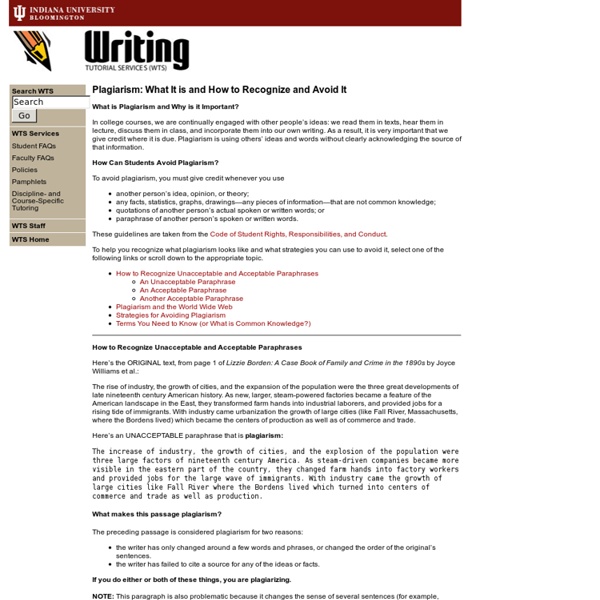Avoiding Plagiarism
Summary: There are few intellectual offenses more serious than plagiarism in academic and professional contexts. This resource offers advice on how to avoid plagiarism in your work. Contributors:Karl Stolley, Allen Brizee, Joshua M. PaizLast Edited: 2014-10-10 09:01:36
Plagiarism Tutorial: Test Your Knowledge
Plagiarism is a serious academic offense! The University of Southern Mississippi's undergraduate and graduate bulletins both include statements about plagiarism: "When cheating is discovered, the faculty member may give the student an F on the work involved or in the course. If further disciplinary action is deemed appropriate, the undergraduate student should be reported to the Dean of Students. A graduate student should be reported to the Dean of the Graduate School."
Plagiarism Scavenger Hunt
Examples: I would be plagiarizing if I were to write an essay about the walrus and said: The walrus' other characteristic features are equally useful. As their favorite meals, particularly shellfish, are found near the dark ocean floor, walruses use their extremely sensitive whiskers, called mustacial vibrissae, as detection devices.
Plagiarism for Dummies: Why Cheating Students Are Missing the Point of Education
To hear college professors tell it, the current wave of student cheating and plagiarism is brand new to higher education. Alas, student plagiarism, especially of the "Can I use your paper for my assignment?" variety, has probably been around since there has been organized schooling, let alone colleges or universities. Fortunately, this problem has never completely taken over colleges and universities for the same reason that college professors crack down on it in the first place. That reason is simple and has been summed up best by the great early 20th century artist Pablo Picasso: "Bad artists copy. Great artists steal."
Why Citations Matter: A Lesson in Preventing “Alternative Facts” - EasyBib Blog
Today, teachers and students alike are inundated with headlines and breaking news stories. We read them in newspapers, on tablets and phones, and consume them live on television. But in a world where “fake news” and “alternative facts” threaten to cloak actual truth, educators everywhere have been presented an incredible teaching opportunity. There has never been a better time than the present to discuss with students of any subject area or grade level the importance of citing reliable sources in research projects.
Plagiarism In The Classroom
For avoiding plagiarism lesson plans … ReadWriteThink provides teachers with a lesson plan for instructing students on the definition of plagiarism, the importance of citing sources, acceptable methods for paraphrasing and more. Literacy Matters has an article for teachers on developing the online research skills of students. In the paraphrasing section toward the bottom, readers will find links to six sites with teacher-specific information on teaching plagiarism avoidance. Plagiarism.org presents educators with extensive resources for understanding plagiarism. Of specific interest to teachers are the tips for plagiarism prevention.
University - College Of Arts and Sciences - Plagiarism
"Academic Integrity is expected of every Cornell Student in all academic undertakings. Integrity entails a firm adherence to a set of values, and the values most essential to an academic community are grounded on the concept of honesty with respect to the intellectual efforts of oneself and others." - Cornell Code of Academic Integrity, p. 1 Plagiarism is the unacknowledged use of the words or ideas of others. It is the most common form of academic integrity violation at Cornell, comprising over 60% of all reported cases within the last three years.
Types of Plagiarism Infographic
LoginBuy Credits Custom Search Types of Plagiarism in Research Infographic
Plagiarism
Parenthetical Documentation (also known as Parenthetical Citation) The parenthetical citations direct your reader to the Works Cited list at the end of your paper. In most cases, the parenthetical citations include the author's last name and the specific page number for the information cited. Note, that the following is the way we would like you to document your work, however, other teachers may have other preferences. Before writing a paper, it's always a good idea to check with the teacher of that course.
Plagiarism Checker
A list of key features: 1. Billions of web pages This tool has the ability to check plagiarism by matching your content against billions of webpages on the Internet.



